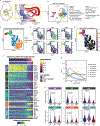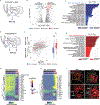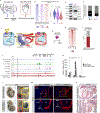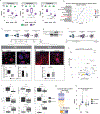Hedgehog signaling activates a mammalian heterochronic gene regulatory network controlling differentiation timing across lineages
- PMID: 36108627
- PMCID: PMC10506397
- DOI: 10.1016/j.devcel.2022.08.009
Hedgehog signaling activates a mammalian heterochronic gene regulatory network controlling differentiation timing across lineages
Abstract
Many developmental signaling pathways have been implicated in lineage-specific differentiation; however, mechanisms that explicitly control differentiation timing remain poorly defined in mammals. We report that murine Hedgehog signaling is a heterochronic pathway that determines the timing of progenitor differentiation. Hedgehog activity was necessary to prevent premature differentiation of second heart field (SHF) cardiac progenitors in mouse embryos, and the Hedgehog transcription factor GLI1 was sufficient to delay differentiation of cardiac progenitors in vitro. GLI1 directly activated a de novo progenitor-specific network in vitro, akin to that of SHF progenitors in vivo, which prevented the onset of the cardiac differentiation program. A Hedgehog signaling-dependent active-to-repressive GLI transition functioned as a differentiation timer, restricting the progenitor network to the SHF. GLI1 expression was associated with progenitor status across germ layers, and it delayed the differentiation of neural progenitors in vitro, suggesting a broad role for Hedgehog signaling as a heterochronic pathway.
Keywords: GLI transcription factors; Hedgehog signaling; congenital heart disease; differentiation; epigenetics; gene regulatory network; heart development; heterochrony; neuronal development; progenitor.
Published by Elsevier Inc.
Conflict of interest statement
Declaration of interests The authors declare no competing interests.
Figures







References
-
- Akerberg BN, Gu F, VanDusen NJ, Zhang X, Dong R, Li K, Zhang B, Zhou B, Sethi I, Ma Q, Wasson L, Wen T, Liu J, Dong K, Conlon FL, Zhou J, Yuan GC, Zhou P, Pu WT, 2019. A reference map of murine cardiac transcription factor chromatin occupancy identifies dynamic and conserved enhancers. Nat. Commun. 2019 101 10, 1–16. 10.1038/s41467-019-12812-3 - DOI - PMC - PubMed
-
- Bademci G, Abad C, Incesulu A, Elian F, Reyahi A, Diaz-Horta O, Cengiz FB, Sineni CJ, Seyhan S, Atli EI, Basmak H, Demir S, Nik AM, Footz T, Guo S, Duman D, Fitoz S, Gurkan H, Blanton SH, Walter MA, Carlsson P, Walz K, Tekin M, 2019. FOXF2 is required for cochlear development in humans and mice. Hum. Mol. Genet. 28, 1286–1297. 10.1093/HMG/DDY431 - DOI - PMC - PubMed
Publication types
MeSH terms
Substances
Grants and funding
LinkOut - more resources
Full Text Sources
Molecular Biology Databases

